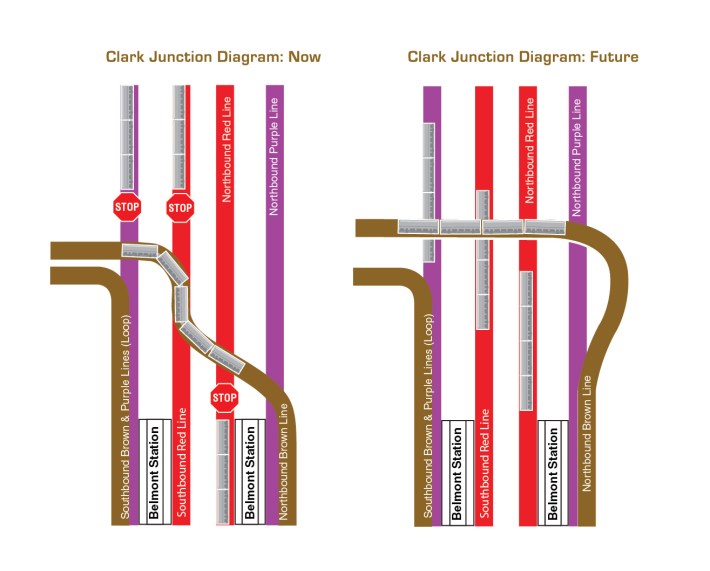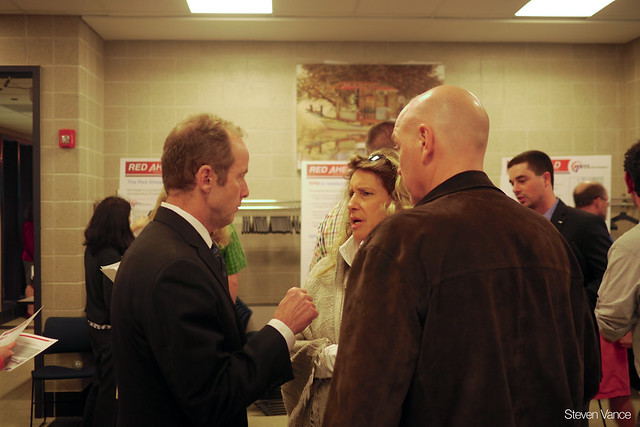Last night, the Chicago Transit Authority explained at a packed open house that it simply cannot run any more Red Line trains through the Clark Junction, the busy crossing one block north of the Belmont station where the Brown Line splits from the Red and Purple Lines. To untangle the crossing, CTA has proposed a flyover that would send northbound Brown Line trains over, instead of in the way of, up to three Red and Purple Line trains that pass every 3-7 minutes during rush hour. CTA spokesperson Catherine Hosinski said that previous news reports, focusing on today's average 84-second delay, miss the point: The project is about improving reliability today, and increasing Red Line service in the future.
CTA added additional trains to the Red Line in 2012, when the Plan to Reduce Crowding reduced some bus service and increased train and other bus service. Materials at the open house now say that "the aging Red Line has reached capacity," and that no new trains can be added during rush hour until Clark Junction is fixed. In addition, delays to any one train that occur today now result in ripple effects down the line, Hosinski said, since the junction's signals are so tightly scheduled. She made an analogy to a street intersection: "Do people make left turns from the right lane, across all other lanes, on city streets? No, because it doesn't make sense...and neither does this 100 year-old design."
The CTA projects that, "if growth continues as it has historically," ridership in 2030 will require twice as many southbound trains – up to 80 trains in the morning peak hour. The Chicago Metropolitan Agency for Planning, our region's comprehensive planning agency, "estimates that over 185,000 new residents will live within half a mile of the North Red and Brown Line stations" in 2040, compared to 2010, and that many of those residents will rely upon transit.
Without the flyover, the CTA says that they won't be able to add more train trips. The Red Line is one of only a few corridors on the North Side that even can be expanded. The area's arterial streets (including Lake Shore Drive) are also already congested, and continued population and job growth will only strain the system further. In the end, growing congestion and continued delays will discourage development on the north side – a rare, but important example of a growing transit-oriented corridor in the Chicago area.
Residents and business owners are understandably upset that their homes and businesses may have to move, if the project is approved by the CTA board and federal government. Jacob Peters, a Streetsblog reader, told the RedEye: "The improvement is direly needed, but I don't think 16 buildings have to be torn down." He suggested using a "scalpel," instead of a "hammer," to carve out a route.
44th Ward Alderman Tom Tunney spoke to many attendees and to Streetsblog. "Of course there's a positive [community impact]. This is infrastructure for the next generation. As a CTA user myself, all you have to do [to see the problem] is go on during rush hour or a Cubs game."
Tunney is concerned, however, that 16 property owners would be displaced. "This is an upheaval for them. One building is a 12 or 14 unit condo building [that was] recently built." He pointed out that this will create another headache for some property owners, especially on Wilton Avenue. "It'll be another ten year planning process," he said, referring to the lengthy Brown Line reconstruction project, "dealing with planning, to execution, and construction, and then another 18 months for redevelopment."
Michael Connelly, CTA vice president of planning, assured the crowd that the design is nowhere near complete. "The renderings here are meant to be conceptual, and to serve as a frame of reference," so that residents would better understand how things might look. He said that after this meeting, CTA will ask the Federal Transit Administration for permission to move forward with engineering and design options, after which they will hold another public meeting. Construction could begin as early as 2017.







